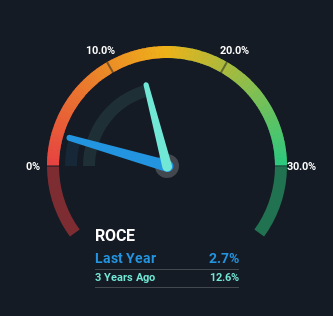Returns On Capital Signal Tricky Times Ahead For Servyou Software Group (SHSE:603171)
Finding a business that has the potential to grow substantially is not easy, but it is possible if we look at a few key financial metrics. Amongst other things, we'll want to see two things; firstly, a growing return on capital employed (ROCE) and secondly, an expansion in the company's amount of capital employed. If you see this, it typically means it's a company with a great business model and plenty of profitable reinvestment opportunities. However, after briefly looking over the numbers, we don't think Servyou Software Group (SHSE:603171) has the makings of a multi-bagger going forward, but let's have a look at why that may be.
Return On Capital Employed (ROCE): What Is It?
If you haven't worked with ROCE before, it measures the 'return' (pre-tax profit) a company generates from capital employed in its business. The formula for this calculation on Servyou Software Group is:
Return on Capital Employed = Earnings Before Interest and Tax (EBIT) ÷ (Total Assets - Current Liabilities)
0.027 = CN¥68m ÷ (CN¥3.8b - CN¥1.2b) (Based on the trailing twelve months to September 2023).
Therefore, Servyou Software Group has an ROCE of 2.7%. Even though it's in line with the industry average of 2.7%, it's still a low return by itself.
View our latest analysis for Servyou Software Group

Above you can see how the current ROCE for Servyou Software Group compares to its prior returns on capital, but there's only so much you can tell from the past. If you'd like to see what analysts are forecasting going forward, you should check out our free analyst report for Servyou Software Group .
What The Trend Of ROCE Can Tell Us
When we looked at the ROCE trend at Servyou Software Group, we didn't gain much confidence. To be more specific, ROCE has fallen from 16% over the last five years. On the other hand, the company has been employing more capital without a corresponding improvement in sales in the last year, which could suggest these investments are longer term plays. It's worth keeping an eye on the company's earnings from here on to see if these investments do end up contributing to the bottom line.
On a side note, Servyou Software Group has done well to pay down its current liabilities to 33% of total assets. So we could link some of this to the decrease in ROCE. Effectively this means their suppliers or short-term creditors are funding less of the business, which reduces some elements of risk. Since the business is basically funding more of its operations with it's own money, you could argue this has made the business less efficient at generating ROCE.
Our Take On Servyou Software Group's ROCE
To conclude, we've found that Servyou Software Group is reinvesting in the business, but returns have been falling. And in the last year, the stock has given away 29% so the market doesn't look too hopeful on these trends strengthening any time soon. Therefore based on the analysis done in this article, we don't think Servyou Software Group has the makings of a multi-bagger.
One more thing: We've identified 3 warning signs with Servyou Software Group (at least 1 which is significant) , and understanding these would certainly be useful.
While Servyou Software Group may not currently earn the highest returns, we've compiled a list of companies that currently earn more than 25% return on equity. Check out this free list here.
New: Manage All Your Stock Portfolios in One Place
We've created the ultimate portfolio companion for stock investors, and it's free.
• Connect an unlimited number of Portfolios and see your total in one currency
• Be alerted to new Warning Signs or Risks via email or mobile
• Track the Fair Value of your stocks
Have feedback on this article? Concerned about the content? Get in touch with us directly. Alternatively, email editorial-team (at) simplywallst.com.
This article by Simply Wall St is general in nature. We provide commentary based on historical data and analyst forecasts only using an unbiased methodology and our articles are not intended to be financial advice. It does not constitute a recommendation to buy or sell any stock, and does not take account of your objectives, or your financial situation. We aim to bring you long-term focused analysis driven by fundamental data. Note that our analysis may not factor in the latest price-sensitive company announcements or qualitative material. Simply Wall St has no position in any stocks mentioned.
About SHSE:603171
Servyou Software Group
Provides financial and tax information services in China.
High growth potential with excellent balance sheet.
Market Insights
Community Narratives



